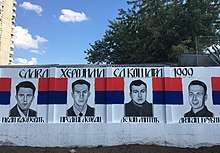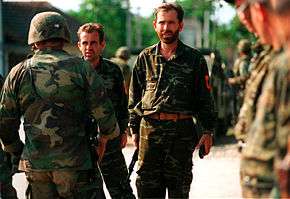Battle of Košare
| Battle of Košare | |||||||
|---|---|---|---|---|---|---|---|
| Part of the Kosovo War | |||||||
| |||||||
| Belligerents | |||||||
|
AFRK |
| ||||||
| Commanders and leaders | |||||||
|
|
(Priština Corps) (Motorized Brigades) | ||||||
| Units involved | |||||||
|
| ||||||
| Strength | |||||||
|
6,000 |
800–1,200[4] artillery[4] and tanks | ||||||
| Casualties and losses | |||||||
| 114–200 killed[5][6] (67 by friendly fire)[7] | 108 killed[8] | ||||||
The Battle of Košare (Serbian: Бој на Кошарама/Boj na Košarama; Albanian: Beteja e Kosharës) was fought during the Kosovo War between the FR Yugoslav Forces and the Kosovo Liberation Army (KLA), the latter supported by the NATO air forces and Albanian Army. The battle was fought around Košare on the border between FR Yugoslavia and Albania from 9 April until 10 June during the NATO bombing of FR Yugoslavia.
The KLA sought to enter Kosovo from Albania and cut off of the communication routes of the Yugoslav Army, and also take over of the region of Metohija. After days of heavy fighting, the Yugoslav Army kept the KLA from advancing into Kosovo. KLA insurgents managed to take the Košare outpost following a massive artillery barrage by the Albanian Army and NATO airstrikes of Yugoslav strategic sites, but were unable to break the Yugoslav Army's second line of defense.
Background
The KLA was supported by the Albanian Army and NATO. The Albanian Army supported with artillery and tanks, NATO with air support.[9]
Timeline
9–13 April
On 9 April 1999, at 03:00, an artillery barrage began from the Albanian side of the border, aimed in the direction of the Košare military outpost, which was occupied by the Yugoslav Army. The Albanians attacked in three directions, the first was towards Rrasa e Koshares, the second was towards the well-defended Košare outpost and the third was towards Maja Glava. Approximately 136 KLA soldiers[10] reached the border and attacked Yugoslav positions. At that time less than 200 members of the Yugoslav Army were stationed at the front line. Bloody fighting ensued and lasted the whole day with 4 dead and one wounded on Albanian side and 23 dead on the Yugoslav side.[11] Later, the KLA seized the peak of Rrasa e Koshares and immediately began entrenching themselves. Serbian reports claim that the KLA insurgents were assisted by British, French, German and Italian special forces.[12]
The battle continued all night until the next morning. Then, with massive artillery support, the KLA took Maja Glava and continued to bombard the Košare Outpost, which resulted in the Yugoslav soldiers having to abandon their posts. At 19:00, members of the KLA entered the abandoned outpost and CNN and the British BBC broadcast images of a great number of KLA militants taking the outpost.
Members of the Yugoslav Forces then retreated towards the second line of defense above the outpost. Those positions were much more easier to defend. The next day, Yugoslav reserve troops arrived to relieve the First Army. One batch of KLA soldiers managed to cut the Yugoslav line of communications, and managed to disable one BOV armoured personnel carrier. During the night, the KLA attacked the Yugoslav Army at Opijaz, trying to shatter the resistance of the Yugoslav soldiers, but all of the attacks were unsuccessful and resulted in the Yugoslav Army inflicting heavy losses on the KLA insurgents. The next day, the KLA tried to break the resistance of the second defensive line of the Yugoslav Army, with little success. Meanwhile, the Yugoslavs managed to bring in their Special Forces and also a few artillery pieces.
On 13 April, the Yugoslav and Albanian armies clashed at the border near Krumë.
Reorganization of Yugoslav positions and counterattack
Albanian Army and KLA artillery continued to shell the Yugoslav Army's positions from Maja Glava and Rrasa e Koshares. The Yugoslav Army Headquarters decided to launch a sudden attack and surprise the enemy. On April 14, Yugoslav troops attacked Maja Glava. The distance between the two enemy trenches wasn't longer than 50 meters. The Yugoslav Army was unable to take Maja Glava completely, but it prevented the Albanians' artillery from engaging them from their positions. The Maja Glava front was stabilized until the end of the war, without any changes on the lines.
In April, there weren't any changes on the front lines at Rrasa e Koshares and both sides suffered heavy losses. Many Yugoslav soldiers were killed by the non-stop artillery bombardment, while many KLA soldiers were killed in numerous unsuccessful attempts to break the Yugoslav lines of defense.
May at Košare
May began with several unsuccessful attacks by the Yugoslav Army to take back the Košare outpost. The attacks were made unsuccessful because of the constant artillery fire aimed at their positions. On the 6th of May, the Yugoslav Army counterattacked at Rrasa e Koshares, in an effort to halt the artillery bombardment. A bloody skirmish ensued, but the Yugoslav Army did not manage to take Rrasa e Koshares. On 10 May, the Yugoslav Army sent two T-55 tanks to help stabilize the offensive on Rrasa e Koshares. When the tanks penetrated the KLA's lines, they advanced over 100 meters into insurgent-held territory, but the KLA still managed to retain control of Rrasa e Koshares. During the night of 10/11 May, NATO bombers dropped dozens of bombs on the Yugoslav troops who had attacked KLA positions around Rrasa e Koshares. At least in two of these instances NATO dropped cluster bombs on Yugoslav army troops. In these attacks, NATO killed eight Yugoslav soldiers and one officer and managed to wound over 40. The KLA seized the opportunity to attack and fought the Yugoslav soldiers out of their positions and forced them back.
During the middle of May, many bloody skirmishes were fought at Mrcaj, which was eventually taken by the Yugoslav Army. After the Yugoslavs had inflicted some casualties on the insurgents, the KLA had to retreat from their positions giving the Yugoslavs the chance to take the now undefended position. This development allowed the Yugoslav Army to stabilize their position on the battlefield and to hold the attackers outside of their line of defense. On 22 May, NATO aircraft mistakenly bombed KLA positions, killing 67.[7]
Throughout May, NATO conducted air operations against Serbian targets in Kosovo and Serbia, some which included collateral damage–death of civilians.[13]
Aftermath


The Kosovo War lasted until 10 June. The Kumanovo Agreement was signed and the Yugoslav Army, paramilitaries and police-forces had to pull out of Kosovo. The KFOR entered Kosovo as a peacekeeping force. The KLA was, under the terms of the Kumanovo Treaty, disarmed and disbanded, however many of its members left Kosovo and joined Albanian organizations in the Insurgency in the Preševo Valley (Serbia) and Insurgency in the Republic of Macedonia.
References
- ↑ di Giovanni, Janina (2012) Madness Visible; A Memoir of War. A&C Black, p. 22
- ↑ KLA shock at Nato blunder The Guardian, 24 May 1999]]
- ↑ Çetta, Muhamet (2003). Me UÇK-në në Koshare : nga vija e parë të frontit dhe nëpër Kosovën e pasluftës : 3 (in Albanian). Prishtina: Faik Konica. pp. Backcover.
Beteja e Kosharës ishte pjesë përbërëse e luftës së përgjithshme të Ushtrisë Çlirimtare të Kosovës. Kjo betejë u zhvillua nga ushtarët e GO-3 (më vonë Brigada 138 "Agim Ramadani" e UÇK-së) të prirë nga eprorët tanë profesionistë dhe kombëtarë: Agim Ramadani, Sali Çeku, Rrustem Berisha dhe Anton Quni
- 1 2 3 Steele 1999.
- ↑ "Pesëmbëdhjetë vjet nga Beteja e Koshares". Telegrafi. 9 April 2014.
- ↑ "Na današnji dan počela bitka na Košarama – poginulo 108 pripadnika VJ". Građanin. 9 April 2015.
- 1 2 "A Kosovo Chronology - War In Europe - FRONTLINE - PBS".
- ↑ Mondo 2016, Građanin 2015
- ↑ "Washingtonpost.com: NATO Gives Air Support to KLA Forces". www.washingtonpost.com. Retrieved 2018-05-15.
- ↑ Musa Gjakova (9 April 2017). "Rrëfimi për Kosharen". Telegrafi.com (in Albanian). Retrieved 23 May 2018.
Brigada 138 në krye me komandantin Agim Ramadani kishte arritur ta thyente kufirin me vetëm 136 ushtarë në njësi të veta.
- ↑ Demaj, Florim (2003). "Chapter six: Rrëfime, Biografi të pasura". In Cetta, Muhamet. Me UÇK-në në Koshare : nga vija e parë të frontit dhe nëpër Kosovën e pasluftës : 3. Prishtina: Faik Konica. pp. 79–80.
Rezultati i gjashtë orë luftimeve ishte nga ana jonë katër të vrarë e një të plagosur, kurse nga radhët e armikut kishte 23 të vrarë
- ↑ ""THE HELL OF KOSHARE"- THE DAY WHEN "300 HUNDRED SERBIAN SPARTANS" STOOD UP AGAINST NATO…". Serbian FBReporter in English. 2015-04-11. Retrieved 2018-05-15.
- ↑ Nardulli et al. 2002.
Sources
- Books
- Bahri Muharrem Gashi (2006). Kosharja altari i lirisë: dimensionet e luftës së Koshares dhe format e saj. Shtepia Botuese "Faik Konica". ISBN 9951061494.
- Smiljanić, Spasoje (2009). Agresija NATO: ratno vazduhoplovstvo i protivvazdušna odbrana u odbrani otadžbine. ISBN 978-86-912285-0-7.
- Nardulli, Bruce; Perry, Walter L.; Pirnie, Bruce R.; Gordin, John IV; McGinn, John G. (2002). Disjointed War: Military Operations in Kosovo, 1999. Rand Corporation. ISBN 978-0-8330-3231-7.
- Coercive Diplomacy of NATO in Kosovo. Cambridge Scholars Publishing. 2015. ISBN 978-1-4438-7668-1.
- Hockenos, Paul (2003). Homeland Calling: Exile Patriotism & the Balkan Wars. Cornell University Press. ISBN 0-8014-4158-7.
External links
- News articles
- Glas javnosti (11 November 1999). "Jačanje upada iz Albanije". Glas javnosti.
- Lazanski, Miroslav (9 January 2009). "КО ЈЕ ПРЕВАРИО ГЕНЕРАЛА" [Who tricked the general]. Politika.
- Steele, Jonathan (17 July 1999). "Ghost village marks the battle that ended the war". London: The Guardian.
- "Na današnji dan počela bitka na Košarama – poginulo 108 pripadnika VJ". Građanin. 9 April 2015.
- Đorelijevski, Miloš (14 June 2016). "HEROJI KOŠARA: Da li je sve bilo uzalud?". Mondo.
- "Kosovska vlada: Bitka na Košarama imala sveti cilj - razbijanje veštačke granice koja razdvaja Albance u dve odvojene države". KSP. 2015.
- Medenica, Mihailo (3 April 2011). "Košare, zadnja vojna pošta srpskih junaka". Press online.
- Marković, Dimitrije (9 April 2015). "На данашњи дан 9. априла 1999. био је Велики петак и почела је битка за Кошаре (ВИДЕО)". KM Novine.
- "Battle of Kosare: When 200 heroes stood against 2000 KLA and NATO soldiers". inSerbia. 12 April 2015.
- "Podsjećanje na 9. april 1999. – bio je Veliki petak i počeo je pakao Košara (VIDEO)". in4s. 2015.
- "У паклу Кошара – неиспричана ратна прича". Politika. 2013.
- "SLOBODAN MILOŠEVIĆ - HAG - 14.02.2002. STENOGRAM". milosevic-trial.org.
- "Pavković otkriva kako je izgledala bitka na Košarama: NATO, OVK i albanska vojska nisu nam oteli ni pedalj zemlje!". Srbija danas. 20 June 2017.
- "Bitka na Paštriku - bitka za Srbiju". Svedok.
- "Komandant odbrane Košara o najtezoj bici kopnene agresije na SRJ". Srbel.net. Archived from the original on May 12, 2013.
- Videos
- "Heroji Bitke za Košare". RTS emisija Dozvolite. RTS (via YouTube).
- "Dozvolite 1363: Bitka za Košare - neispričana priča". RTS emisija Dozvolite. RTS (via YouTube).
- "Досије Кошаре 1999 / пролог".
- "DIREKTNO KOŠARE 03 10 2017".
- "Пакао! Херојска одбрана Кошара 1999. године 12.09.2017".
- Milovan Drecun: Pakao Košara, a documentary about the battle